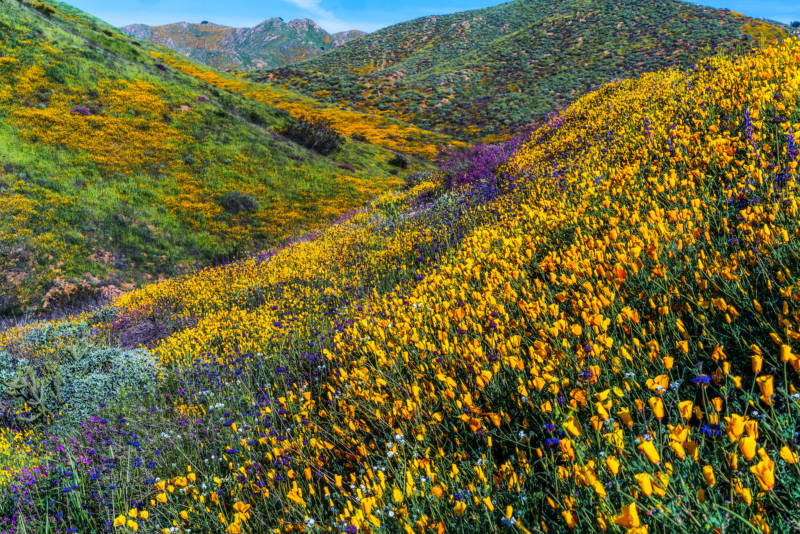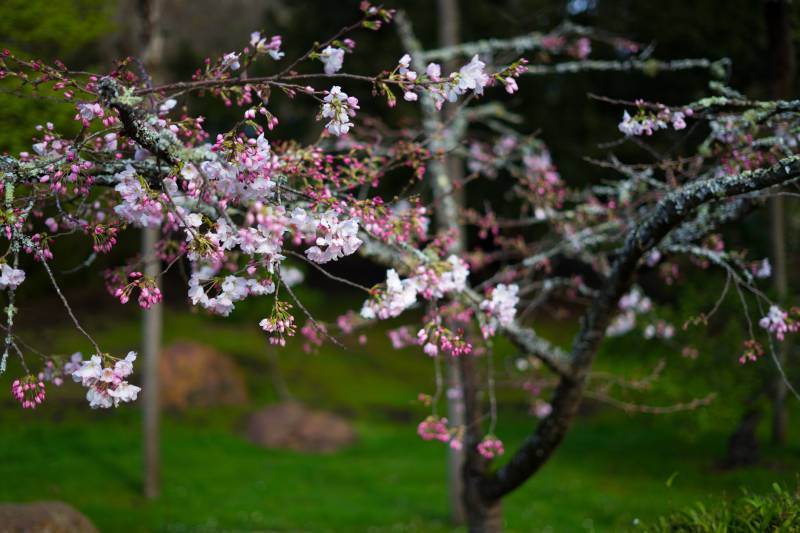Updated 11:30 a.m. Monday, May 15
If you’re in the Bay Area, you might have noticed that trees have been splendidly in bloom around the region since early February. Vibrant wildflowers are popping up around California, a sight of bursting color that many look forward to every year — as much as they look forward to striking-looking invasive species that carpet the hillsides.
Spring is in the air in a big way, thanks to the abundant rain we’ve received so far. So you might be wondering: Will there be a “super bloom” this year? Where are the best places to see wildflower blooms in the Bay Area? And what’s the science behind the seasonality of plant blooms?
What are super blooms, and can we see them in the Bay Area?
Wildflower lovers have no doubt been thrilled by recent images of Southern California super blooms visible from space.
California is the most biologically diverse state in the country, home to about 8,000 species of plants. Over 2,300 of those are wildflowers, says Cameron Barrows, conservation ecologist at the Center for Conservation Biology at UC Riverside.
“Super bloom,” he says, is not a scientific term, and is mainly used by the media to describe incredible bloom events that are not very common, when many different species of wildflowers bloom at the same time. “There might be anywhere that’s 50 to 100 different species in bloom during a super bloom event,” Barrows said.
The right amount of rain and temperature set the stage for a super bloom. “I refer to this as sort of a global ‘Goldilocks scenario’ where [it’s] not too much rain, not too little rain — not too hot, not too cold,” said Barrow. “When it is just right, then lots and lots of species will bloom at the same time.”
The best blooms happen when we have a wet year followed by a strong drought, according to Richard Minnich, professor at the Department of Earth and Planetary Sciences at UC Riverside. He says that the drought suppresses invasive species or annual grasses, leaving room for the wildflowers to take off.
Minnich cites the super bloom event of 2005 in Death Valley as a great example of this, saying it was “after one of the wettest winters we would ever see, and it also followed some dry weather.”

This month, sight seekers have been flocking to see the latest blooms in the state. But while these new colors are striking, we’re still not seeing a California super bloom of the magnitude seen in 2005 or the colorful super bloom explosion of 2019, says Barrows.
That’s because this latest desert wildflower bloom “has been good but confined to desert washes where rainfall runoff has been concentrated,” said Cameron. “Beyond the boundaries of the washes very few wildflowers have bloomed, and the high temperatures are now wringing all remaining moisture from the desert sands.”
We’ve had exceptional rainfall so far in 2023, occurring earlier than in previous years. This encourages invasive plants to germinate earlier, taking over the opportunity for native wildflowers to bloom. And ideally, for a true super bloom to occur, we’d need that “Goldilocks” balance to ensure that invasive plants don’t dominate and the native plants can “complete their entire life cycle,” Barrows said.
We’ve also had very cold weather these past few months, extending the bloom period to later in the spring, says Minnich.
This year, wildflowers will “bloom later into the spring,” he said. “Once they start they’ll last longer because the ground is obviously really wet.”
Where and when can you see blooms in the Bay Area?
If you’re planning to head out on a trail to enjoy these wildflower blooms, be sure to respect the landscape and stay on designated trails. Do not trample or pick any flowers, and pack out anything you pack in. And be sure to check the park’s website for any closures or updates on current conditions. It’s also worth noting that if you have allergies, be sure to be prepared with medicine, and take preventative measures before embarking on your wildflower journey.
Be aware that “there’s this entire ecosystem that the flowers are helping to support,” urged Barrows. He says that when you damage the wildflowers, “you are then not only impacting the bees and the butterflies and the hummingbirds and the animals that eat the flowers and eat the seeds and so forth,” but also the opportunity for future super blooms.


